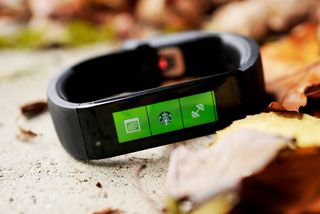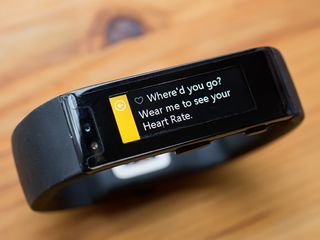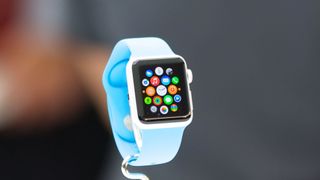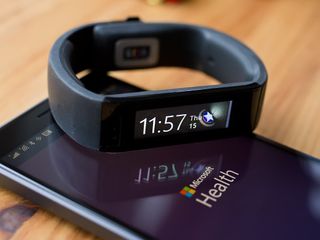How the Microsoft Band will beat Apple's Watch
Am I really positing that the Microsoft Band will beat the Apple Watch? Yes, I am.

How will they accomplish this you ask? While Apple is diligently courting the elite, Microsoft is purposefully launching out into the deep, and they are aiming to commandeer the seas.
Today Apple is priming the masses for the Watch's maiden journey into the "waters of wearables" (see our coverage on iMore). Microsoft by contrast is more subtly and methodically building a system to immerse itself in the developing currents that are directing the wearables market.

All Aboard – Taking Shape
Microsoft's ambitious CEO Satya Nadella has his head in the cloud – and that is a good thing. He envisions a world where a user's experience exists in that ephemeral space "between" devices. To the typical user that space is an invisible "magical" place that is trusted to carry one's experience seamlessly across their connected devices that themselves act as a tangible portal to that immaterial realm.
To Microsoft, that space is the cloud that functions as an intelligent platform to store data from millions of users. The cloud can then process that data, interpret it and proactively communicates relevant and contextual information back to individual users in a meaningful way.
The Microsoft Band is endowed by the Redmond company with 10 sensors that collect external data that is processed in the cloud and delivered to users so that they can make consistently informed decisions about their health. The system is analogous to how our five senses collect visual, auditory, olfactory, tactile and gustatory (taste) input that is then communicated to our brains.

The persistently observant optical heart rate monitor continuously monitors a user's heart rate. The 3-axis accelerometer and gyrometer monitors a user's motions. GPS , which can work independent of the phone, collects data on a user's activities such as runs. The microphone listens for voice input. An ambient light sensor senses changes in lighting. Galvanic Skin Response (GSR) sensors enables the device to "know" when it is being worn. The UV sensor perceives the UV index and providing valuable data for a user's protection from the sun's harmful rays. The skin temperature sensor keeps track of body temperature. The capacitive sensor allows the device to perceive a user's touch.
All 10 of these unique sensors have been developed by Microsoft and crafted purposefully into a single device. Those sensors create a continuous portal between a user's daily activities (from sleeping to the evening jog) and the cloud. The cloud is designed to provide a user with the support based on their unique health profile.
Get the Windows Central Newsletter
All the latest news, reviews, and guides for Windows and Xbox diehards.
Positioned as a fitness band that is designed as a continuous support Microsoft touts that the Band lasts 2 days on a full charge. Combined with the relatively swift 1.5 hour recharge time, downtime, where the band is not actively serving a user is minimal. By crafting a device that does not demand extensive time away from the user Microsoft has built a fitness band that is well positioned to become a staple in a user's daily life.
This is a crucial component in the success of such a device. Not all devices provide this level of continuity as we will see.

The Shape of Things
Microsoft's wearable is a fitness band. It is not a watch, nor does it try to be. I wrote an earlier piece that analyzes in depth the contrasting positions between a band and a watch. In short, Microsoft designed a wearable whose form followed the desired function. What is the desired function?
As we have already mentioned the Band is designed to monitor a user's health and activities throughout the day and serve as a portal to Microsoft's intelligent cloud-based Health platform. What we have not discussed is the Bands ability to act as a window to the user's primary device. This design allows the user to field notifications, phone calls, and messages and to perform a host of other "Smartwatch" like tasks. All of this while retaining the form, market positioning and power consumption advantages of a fitness band.
This is where the Microsoft Band shines. In a market that is at yet undefined, where bands of various forms and smartwatches of numerous flavors have hit the market, consumers have not yet fully embraced either. There is still uncertainty in the market in which the masses have not embraced any wearable.

It is telling however that even regular watches as an accessory have fallen out of vogue. Most of the smartphone-toting masses have forgone the wristwatch deferring to their more than capable smart devices to pick up the duty of helping them to keep pace with the time. That watches are far less popular as an everyday accessory (than they were a couple of decades ago) is an inherent barrier to any wearable positioned in the market as a watch.
To entice users to embrace that long forsaken, arguably archaic, form factor many smartwatches may require a multitude of gimmicky tricks or luxury branding that come reduced operation time due to power constraints. Such reduced operation time inherently reduces the efficacy of any device that is also meant to monitor a user's health continuously.
According to Mark Gurman of 9to5Mac, the Apple Watch suffers just this problem. With regular use, it lasts half the time, one (1) day, of the Microsoft Band that lasts 2 days on a full charge (more like 30 hours). The Apple Watch also requires up to over three (3) times the recharge time of the Microsoft Band to replenish a charge. The Microsoft Band requires 1.5 hours where the Apple Watch ranges from 4-5 hours before it is ready for a full days use (although a recent report on TechCrunch suggest it may be as low as 2 hours).
It is easy to see where there will be lulls in the ability of the Apple Watch to keep consistent data for a user. If a user decided to recharge while they were asleep, then they forgo the touted sleep monitoring function. This is less of a challenge for a Microsoft Band wearer who could find a 1.5 hour recharge window much more quickly than an Apple Watch. The Microsoft Band can also do a fast-charge in 30 minutes, making recharging while in the shower ideal for most users.

Form Follows Function
Microsoft's choice to design a wearable where the form__followed function allowed the Redmond company a device that benefits from the strengths of a fitness band (such as lower power consumption) while also incorporating many of the features of a smartwatch. The fundamental functions that any consumer of either the Microsoft Band and or the Apple Watch are looking for is consistent health monitoring and the ability to field notifications from their phone. Microsoft's Band fulfills this expectation.
Apple seems to have followed the premise that if it is on the wrist then it is a watch. Consequently, the Apple Watches function appears to be following the form. Apple has been promoting numerous smartwatch functions that take advantage of the larger and higher quality display – functionality that goes beyond the basic consumer expectation of _consistent _health monitoring and fielding notifications and other alerts.
As a result of the Cupertino's company's desire (or need) to make use of that form the user will apparently suffer from extended time away from the device due to high power consumption. This extended downtime (compared to the Band) results in reduced health monitoring. This reduction is dangerous considering Apple's promotion of continuous health monitoring throughout the day including while one is asleep.
Though the market has not yet decided which way it will go with wearables it is clear that fitness bands have garnered more of the attention of the purchasing masses than smartwatches. The public, to this point, have been speaking with their hard-earned cash on which form factor appeals more to them.
Microsoft with its Band was wise to meet the people where they are rather than try to persuade them to wear a device that they may not wish to wear. By entering the wearable space with a Band, they have come from a position that offers far less mental inertia to consumers than what Apple is doing. By presenting a category of device, a smartwatch, that requires enticing functionality that limits the effectiveness of fundamental features.

The Cupertino Effect
That said Apple is a marketing powerhouse and has exhibited a proven ability to tell people what they want and have them listen. It is clear that Apple's efforts to position the Watch as a luxury item, as evidenced in its 12 page spread in Vogue, and its high price, starting at $350. Apple is trying to entice people to want the Watch rather than meeting them where they are and fulfilling a demand. Without question because of Apple's brand their entry into this space adds credence to the wearable category. Those companies already present stand to benefit from the attention and validating the effect Apple's presence has on the market. Microsoft's recent restocking of Microsoft Bands three days before Apples March 9th, 2015 event is evidence of their awareness of this effect. The additional note that 765 Best Buy stores will also be selling the Band presumably before Apple's watch hits the market is also evidence that Microsoft is keenly aware of Apple's effect on the market.
Will people buy the Microsoft Band? Yes.
Will people buy the Apple Watch? Yes.
Microsoft, however, has invested in the form factor that has proven most successful in the industry thus far and has created an aspirational item. This design choice shows what a fitness band is capable of in its core functionality as well as more advanced "smartwatch" like functions without forsaking an advantageous form factor.

Smarter than the Average Band
Unlike many bands on the market Microsoft's decidedly positioned aspirational device incorporates much of the functionality found on a smartwatch. In addition to fielding smartphone alerts and notifications, the home screen is customizable. The Band allows for productivity and social media integration. It is open to third party developers. It has an intelligent keyboard, a quick read function and Cortana, Microsoft's popular personal assistant is integrated with the device (for Windows Phone users). The Microsoft Band is a powerful and reliable health agent which also provides guided workouts, and it fulfills the consumer need for monitoring and navigating one's smart device without the inconvenience of consistently retrieving it from your pocket.

Silver Lining
Microsoft's Cloud-based Health platform is a key component in Microsoft's strategy to provide users with relevant health data. The Band is simply the portal, or interface, to that platform. Apple has a health platform (as does Google). However, only Microsoft's Health platform is device and services agnostic allowing it to be used by all other OEMs with other health monitoring devices/services. This strategy positions Microsoft to be the platform that powers a myriad assortment of wearables across the industry. As partners join with Microsoft, the Redmond company becomes the current upon which diverse OEM devices flow.
Selling devices, though desirable, is not the ultimate goal for Microsoft. Microsoft Health and cloud-based computing is.
Making Sense
The 10 sensors that give the Microsoft Band its perceptive powers are also a means by which Microsoft is extending its reach into the depths of the wearable space. Microsoft has announced that the sensor technology can be licensed by other OEMs and implemented in their brand of wearable tech. So with the introduction of a fitness based wearable, Microsoft has exhibited an express investment in the fitness focused, space. Via the Band they have opened a portal to any OEM, who wishes to use their Health platform. Via a multifaceted approach to influence the wearable space they have also provided sensor technology that may also find its way intricately interwoven throughout the wearable industry as OEMs license the technology.
Microsoft would rather own the ocean we are in than the boat we are on.
Apple Watch uses proprietary technology that is limited only to the Apple ecosystem. Apples Health platform too precludes the use of non-Apple devices such as a Windows or Android phones.

Altogether Now
Unlike Apple Watch, the Microsoft Band is cross-platform. Microsoft, in line with their cloud first, mobile first model has made the Microsoft Band a wearable that anyone who is locked into any ecosystem can freely use and benefit from. Android, iOS, and Windows users can all share the health benefits and many of the smartwatch like benefits the Band offers.
This open access allows Microsoft to permeate the wearable space in such a way that they lay the foundations to be a key player in mobile health.
The Price is Right
Whereas Apple is apparently intentionally targeting a price point that positions their device at the high end of the market at $350, Microsoft's $199 price point makes the Band a more accessible option.
Many consumers whose attention are drawn to the wearable space by Apple's undeniable marketing power may find that even the lowest cost Apple Watch is beyond their reach. The Microsoft fitness Band, which performs all of the necessary health and notification functions as the Apple Watch, is simply more affordable.
Though working hard with partners from various disciplines Apple may have a difficult time, trying to carve out a niche market at the Watch end of the wearable space, where cost is a factor. Apple has proven successful in convincing people that their products deserve the premium price tag. This is the direction Apple appears to be going with the Apple Watch to differentiate it from the competition.
The profound challenge for Apple in this space is the dichotomy of form factors that exist within the area vying for acceptance. The fitness band or smartwatch product space is still as yet undefined and generally unaccepted by the masses.
I believe Microsoft's comprehensive, swift, open and collaborative approach to a relatively affordable fitness focused (in form and function) wearable positions them to better define the category to the masses via partnerships. This will further marginalize Apple to a very narrow portion of the wearable space – luxury smartwatches within a closed ecosystem. With the profit margins Apple would garner in that space this would not be entirely bad for Apple. However, it does leave the rest of the space- a gigantic area- potentially well positioned to be greatly influenced by Microsoft's efforts to be the platform for wearables.

Own the Ocean
Microsoft has positioned itself to be a partner with the multitude of players in Wearables. The Microsoft Band is positioned to beat the Apple watch. Not the Band itself but what the Band achieves. It has acted as the tool to introduce an ecosystem of health services, sensor technology and functional form factor to a growing industry of fitness trackers and health-focused smart wearables.
Microsoft's highly visible partnership with Fitbit and their cross promotion of Lumia and Fitbit devices is an initial example of what Microsoft's goals may be in regard to collaborations with those in the industry. By supporting other players in the space, Microsoft nurtures a relationship that may potentially see more of their technology and services integrated with the devices of the OEMS with whom they partner.
By presenting themselves as an open platform to the various players in the industry via the Band and the combination of services and technologies it represents, Microsoft positions themselves to potentially permeate multiple layers of the wearable space. Own the ocean.
Yes this strategy positions the Band to beat the Apple watch. As the wearable space (further spurred by Apple's entry) begins to grow, Microsoft's deliberate positioning of itself as the platform for all gives the Redmond company a potentially ubiquitous presence and industry influence. An ocean of opportunity if you will that over time Apple's niche space cannot rival
I may be wrong. Then again, I may be right. Either way let's not get caught up in Apples glitz and glam. Let's be smart and watch.
Jason L Ward is a columnist at Windows Central. He provides unique big picture analysis of the complex world of Microsoft. Jason takes the small clues and gives you an insightful big picture perspective through storytelling that you won't find *anywhere* else. Seriously, this dude thinks outside the box. Follow him on Twitter at @JLTechWord. He's doing the "write" thing!

